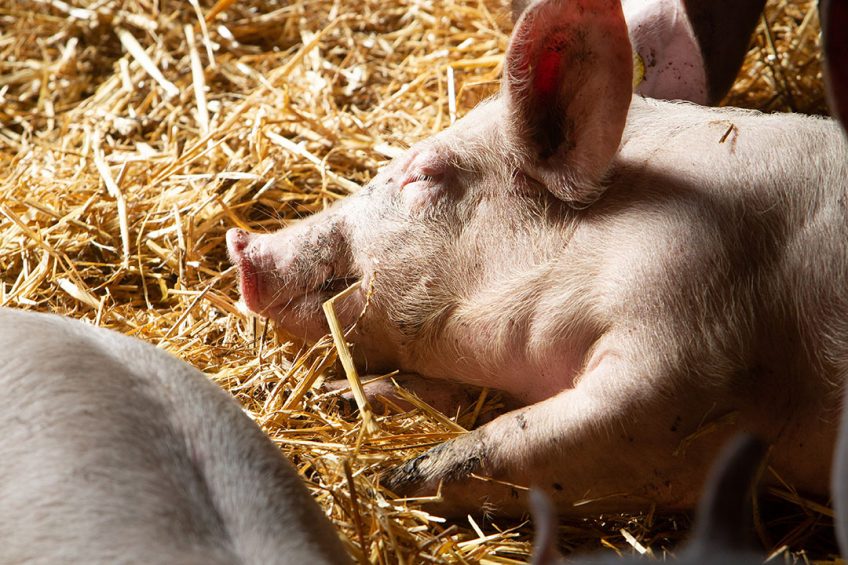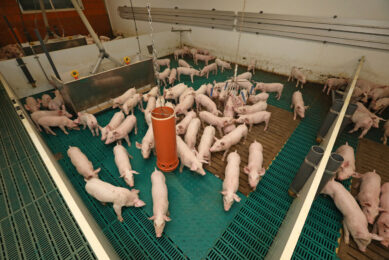Deep straw in pigs – when does it work?

Pig management expert John Gadd became intrigued by a recent farm visit featuring a pig farm in Germany, keeping pigs on straw. Here is his view on that development – and what it takes to make it into a success.
I continue a short series on good ideas in pig production which I feel deserve further comment. There have been some excellent articles in Pig Progress recently. One was on the economics of deep straw bedding for growing pigs.
The ins (and outs) of deep straw
Living and working in a predominantly cereal growing area, I grew up with deep straw both for dry sows and post-weaners and have long been a firm convert, so was glad to see the costings of one enterprising German farmer in Pig Progress (in December 2018) comparing both new conventional and new fully automated deep straw housing for 2,000 grow-finishing places. His careful costings revealed that the relatively new straw-bedded housed pigs cost € 58/pig place (12.7%) less than the equally new conventional housing.
From his records the straw bedded pigs performed similarly to the conventionally housed pigs but no figures were provided for the cost of straw which these days can be expensive. Some 10 kg of straw was needed per 10 kg of feed – about 30 kg of straw per pig place (per batch?) through to slaughter, one presumes from leaving nursery accommodation.
Drawbacks of deep straw
What is of interest is that an additive is added to the straw to facilitate composting and reduce the physical labour needed to keep the straw bed ‘working’ which we found could be a disadvantage, and along with the cost of straw puts people off. So this innovation of pre-treating the straw into a marketable compost is important. Big Dutchman can advise on what the German producer uses.
On the other hand, most deep straw units in a cereal growing area, especially where the producer feeds his pigs from his own farm-grown grain and stores, then distributes used straw bedding on to his cereal acreage, makes the deep straw concept viable.
Read more expert opinions in Pig Progress’ expert corner
But outside cereal-rich farmland I have always found that careful calculations on the cost of procuring ‘off-farm’ straw and the cost of removing it economically must be considered and factored in to the proposition. Farmers can be easily swayed by observing how calm and contented any pig is in a deep straw bed.
Housing cost can be much cheaper
It is worth remembering that many existing deep straw-bedded units already have buildings available or have hired them from neighbours such as disused cattle courts, which have run out very cheaply. From the records of 8 of my clients, a saving of around 45% from a conventional solid or slatted floored building and with slight modifications and despite an 8% increase in labour cost (to keep the bedding ‘sweet’) have made such conversions attractive.
Also many Electronic Sow Feeding (ESF) dry sow installations are on deep straw although a different layout design on hard standing is perfectly viable.
Last month, John Gadd summed up several useful ingredients to deal achieve a better gut health in pigs
Do deep strawed pigs perform better?
From the contentment angle it seems that they ought to. But I have been disappointed to find that there is a slight improvement in-the-nursery-onwards pigs which is usually increased by about double to slaughter, but records when available have thrown up little difference (see Table 1), which seems typical today. However, 2 clients report Meat produced per Tonne of Feed (MTF) improvement over slatted housing of 13 kg.
Moving straw in and out
Looking back on my clients’ records (11 farms) since 2000, their operating costs, i.e. moving straw in and out as muck, and labour costs rose by 1% on the total cost of producing a finished pig.
Conclusions on deep straw in pigs:
- Deep straw is viable, but needs careful operating calculations if not in a cereal-based locality;
- If so, the German method of treating the straw beforehand looks to be a useful development as it removes nearly all the disadvantage of the physical labour needed to manage the deep straw;
- Done well, the pigs seem very content. And their owners pleased. There is less aggression;
- Disease varies. Converting to deep straw on a shoestring i.e. over-stocking, will increase the risk of disease. Deep straw needs ample space.











